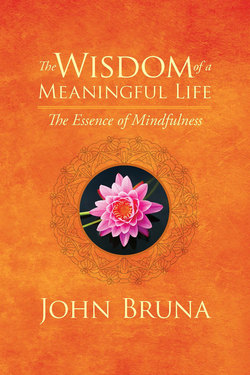Читать книгу The Wisdom of a Meaningful Life - John Bruna - Страница 16
На сайте Литреса книга снята с продажи.
ОглавлениеCHAPTER FOUR
Attention
“But it is extremely important to check and see if whatever meditation we do is an actual remedy for our suffering.” LAMA YESHE
The first step—and one of the key components to living mindfully—is learning how to tame the unruly mind and cultivate attentional balance. In other words, we must learn how to direct our attention where we want it and hold it there. Ultimately, this is the only way to establish free will in our lives.
It is a common myth that we have such free will and use it daily. As described in the previous chapter, most of our choices and reactions are triggered by an unruly mind based on distorted perceptions; they are not conscious choices based in reality. If we are to have free will in our lives, we have to be fully available to make the choice. This means we need to be present in the current moment with clarity and wisdom. Instead of having the mind drag us around from one thought or feeling to the next, we need to train the mind to serve us in the healthiest way possible.
If we observe the mind, we will notice that it tends to be either overly active—ruminating, planning, reminiscing (often referred to as “monkey mind”)—or tired, such as when we can’t muster the energy to pay attention. These two states are often described as excitation and laxity. The mind tends to be either too excited or too lax. Rarely is it relaxed, stable, and attentive.
This dual tendency toward excitation and laxity has been noted in many wisdom traditions throughout time. Most people just get used to it and accept is as a normal state of mind. However, it is not our normal or natural state of mind. The natural state of the mind is blissful and luminous. In fact, when the mind is calm and clear at the same time, it returns to its natural state and happiness spontaneously arises. Unfortunately, the obsessive, compulsive, and delusional activities of the mind obscure its true natural state. This state is verifiable. It has been consistently replicated by meditators over thousands of years, yet it eludes the vast majority of us. When we are able to cultivate attentional balance, avoid getting caught up in excitation or laxity, and develop the ability to focus our attention in a relaxed, stable, and clear way, only then will we discover this natural state of mind.
The method of cultivating attentional balance that has been refined over thousands of years is available to us in shamatha meditation. Shamatha means calm or peaceful abiding. This practice was developed to cultivate concentration, calm the turbulent mind, and abide in its natural state. This specific meditation practice is the antidote to the most detrimental mental affliction we have: the obsessive and compulsive mind. But before I begin to unveil this method further, let me say a few words about meditation.
First, the form of meditation I am suggesting is simple and can be done by anyone. You do not need to climb a mountain, sit in full lotus position, or learn any complicated visualizations. It is as simple as learning to relax your body, breathe naturally, and pay attention. Second, there are many different types of meditation, and all of them are designed with a specific purpose in mind. The great teachers of all meditation traditions emphasize that it does not matter so much whether we sit this way or that way, do this meditation or that meditation; what matters is whether our meditation counteracts our mental afflictions.
This is an extremely important point, and one I believe is frequently overlooked. So often we hear studies indicating that meditation has all sorts of wonderful benefits. Beautiful posters tell us that if we all meditated the world would be a peaceful place. Unfortunately, these claims are often out of context and not entirely true.
Meditation can have a beneficial, non-beneficial, or neutral effect on us. We can use meditation to escape the responsibilities and challenges of life, or to face them. We can use meditation to concentrate all our energy on selfish means, or on helping others. We can do elaborate meditations working with energy and, without proper guidance, actually damage our bodies. We can also use certain meditations, understanding their specific purpose and with guidance from a qualified teacher, that enable us to alleviate, if not eliminate, mental and physical afflictions, and improve our quality of life.
So remember: When learning to meditate it is important to understand the purpose of the meditation, the directions of the meditation, and how it addresses our afflictions. The shamatha meditation I suggest is very safe, easy to learn, and can be extremely effective in cultivating attentional balance.
Because many of us do not have a great deal of freedom and time to participate in hours of training, practice, and meditation, it is important to use what little time we do have to meditate in the most effective way. Most people I’ve taught over the years are fortunate if they have thirty minutes a day to dedicate to formal meditation practice. We lead very busy lives, and it can be challenging to break old habits and create the time for a meditation practice.
So, if you are able to meditate for only ten, twenty, or thirty minutes, why not choose the meditation that directly counteracts our biggest obstacle, the unruly mind? That is the specific purpose of shamatha meditation practice. Developing a regular shamatha practice will even improve the quality of your other meditation practices, as is provides a greater level of mental stability for them.
